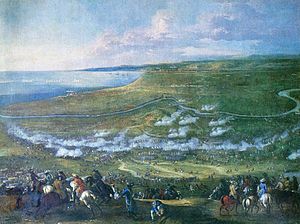Battle of Halmstad
| Battle of Halmstad | |||||||
|---|---|---|---|---|---|---|---|
| Part of the Scanian War | |||||||
 Battle of Halmstad by Johann Philip Lemke | |||||||
| |||||||
| Belligerents | |||||||
|
|
| ||||||
| Commanders and leaders | |||||||
|
Charles XI Field Marshal Simon Grundel-Helmfelt | Major General Jakob Duncan | ||||||
| Strength | |||||||
| 6,000 men[2] | 3,500–4,000 men[3] | ||||||
| Casualties and losses | |||||||
|
200:[4] 144 wounded |
3,000:[4] 2,000 captured | ||||||
The Battle of Halmstad (also known as the Battle at Fyllebro) was fought on August 17, 1676, at Fyllebro, approximately five kilometers south of the town Halmstad in southwest Sweden. It was the last battle in Halland between Denmark and Sweden.
Prelude
The Danish army that landed at Helsingborg in Scania in late June 1676 managed to conquer almost the whole province in less than a month. The Swedish army had to retreat north to Växjö.[5]
In early August, General Jakob Duncan with about 4,000 Danish troops was sent north, to the province of Halland, to take Halmstad and if possible advance further north to join General Ulrik Frederick Gyldenløve, who had reached Gothenburg with a Norwegian army and was threatening to besiege the city.[5]
On August 11, King Charles XI and his small army headed west to intercept Duncan. General Duncan had been informed about Swedish troops heading in his direction but as he assumed that it was just a smaller unit under General Ascheberg, he made no haste when he decided to leave Halmstad and return south to Scania. At noon of August 17, the Swedish army reached the only road from Scania to Halmstad and Duncan was trapped. The Swedes destroyed the bridge leading south and headed north.[6]
Battle
After just a few kilometres the Swedish vanguard under command of Ascheberg encountered a small Danish unit that was routed back north. After a short chase Ascheberg found himself face-to-face with Duncan and his forces.[7] The Danish army was about to cross the bridge over the creek Fylleån. Duncan, who thought that the approaching enemy troops were the entire Swedish force, continued to let his men cross the bridge. Unaware of the danger he let his troops assume battle formations on the south bank with their backs against the creek.[7]
Meanwhile, the Swedes brought forward the rest of their cavalry and infantry, which had been lagging behind. The battle started with a salvo from the few Swedish cannons, whereupon Charles XI and his Household cavalry charged down the hills to attack the Danish left wing. Soon the Swedes also charged on the left wing[clarification needed] and in the center. After 15 minutes the Danish left wing was scattered.[7] In the center the Danish infantry put up a determined fight, with a powerful counter-attack from a cavalry unit that tried to break through the Swedish lines, but only one squadron made it through.[7]
At this point Duncan had realized his mistake and ordered his remaining troops to retreat back across the bridge. But the Swedish cavalry on the right wing found a ford and started moving fresh cavalry squadrons across the creek. Understanding that the battle was lost, Duncan surrendered. The action had lasted for little more than an hour.[7]
Aftermath
The defeat at Halmstad dealt a hard blow to the Danish plans to advance north and to make contact with the Norwegian army. The day after the battle the Danish King Christian V broke his camp at Kristianstad and started marching towards Halmstad. On September 5 he reached Halmstad and begun besieging the town with no result. Three weeks later he returned to Scania to find quarters for the winter.[5]
The battle at Fyllebro was also 20-year-old Charles XI's first major victory. It was an important morale boost for him, his generals, and the whole Swedish army. The army was still much too weak to confront the Danes in Scania and marched north to Varberg to await more troops.[1][8]
See also
References
- ^ a b "Slaget vid Halmstad den 17 augusti 1676" (PDF) (in Swedish). lansstyrelsen.se/halland/. 2010. Archived from the original (PDF) on 24 December 2013. Retrieved 15 August 2020.
- ^ Rystad 2005, p. 98.
- ^ Rystad 2005, p. 97.
- ^ a b Rystad 2005, p. 102.
- ^ a b c "Historiska årtal". Archived from the original on November 17, 2014. Retrieved 14 August 2015.
- ^ "halland.se – Slaget vid Halmstad 1676". Retrieved 14 August 2015.
- ^ a b c d e "halland.se – Minnessten om slaget vid Halmstad 1676". Retrieved 14 August 2015.
- ^ "Battlefields in Halland". Retrieved 14 August 2015.
Sources
- Rystad, Göran (2005). Kampen om Skåne [The fight for Skåne] (Revised ed.). Lund: Historiska Media. ISBN 91-85057-05-3.
{{cite book}}: Invalid|ref=harv(help)
